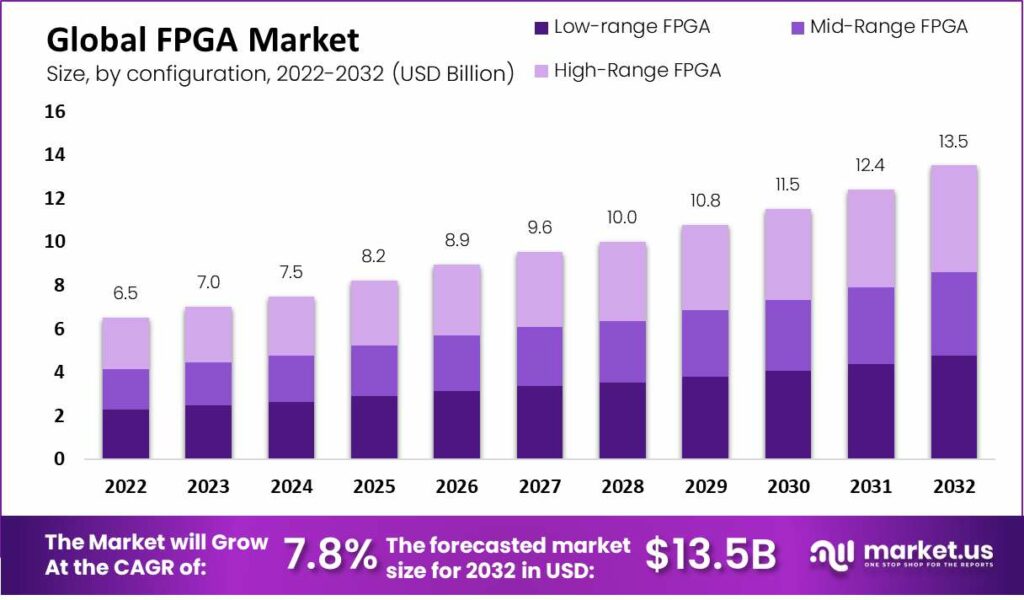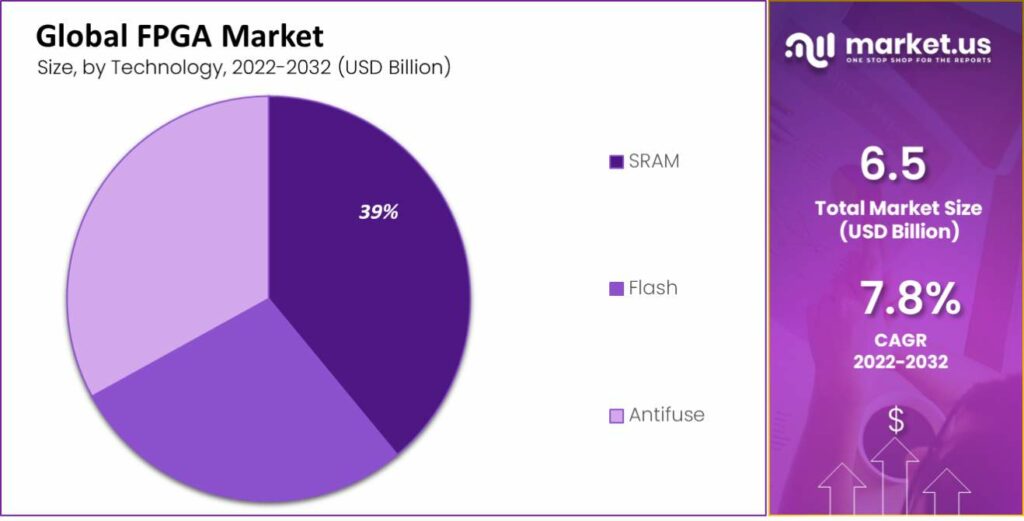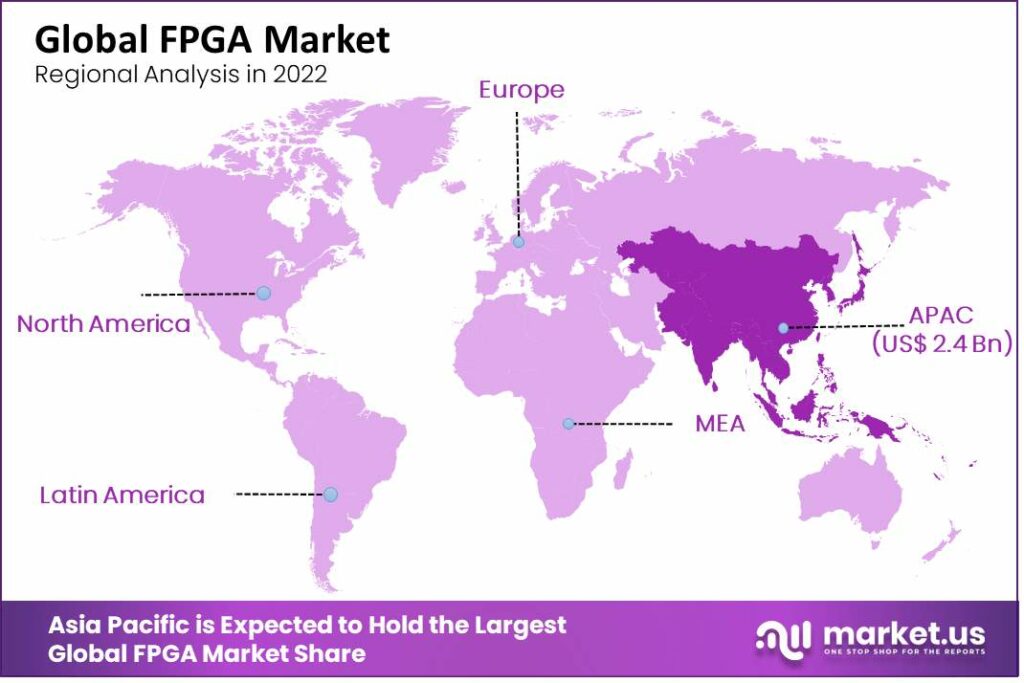New York, Feb. 06, 2024 (GLOBE NEWSWIRE) -- According to Market.us, The Field-Programmable Gate Array (FPGA) Market size is expected to be worth around USD 13.5 Billion by 2032, from USD 7.0 Billion in 2023, growing at a CAGR of 7.8% during the forecast period from 2023 to 2032.
Field Programmable Gate Arrays (FPGAs) are integrated circuits that can be configured by the customer or designer after manufacturing - hence the term "field-programmable". This flexibility allows FPGAs to be used in a wide range of applications, from simple logic control to complex digital signal processing. The FPGA market has witnessed substantial growth, driven by the increasing demand for faster data processing and the need for customizable hardware in sectors such as telecommunications, automotive, and data centers. FPGAs offer the perfect blend of flexibility and performance, making them ideal for prototyping, product development, and even in the deployment of specialized hardware accelerators.
With the rise of AI, machine learning, and the Internet of Things (IoT), the demand for FPGAs has surged, as they provide the necessary computational power and adaptability required by these technologies. FPGAs are also increasingly used in edge computing applications, where processing data closer to the source is critical to reduce latency and improve efficiency. The company reported a 50% boost in throughput for Bing by employing FPGAs to enhance search ranking.
Tap into Market Opportunities and Stay Ahead of Competitors - Get Your Sample Report Now

Important Revelation:
- The Global Field-Programmable Gate Array (FPGA) Market is likely to reach USD 13.5 billion by 2032. The market is further expected to surge at a CAGR of 7.8% during the forecast period 2023 to 2032.
- Low-range FPGA segment was dominant in the market, with the largest market share of 35.2%, in 2022.
- The Static Random-Access Memory (SRAM) segment holds the largest market share, with more than 39% in 2022.
- The 20-90 nm node-size segment dominates the global Field-Programmable Gate Array (FPGA) Market with the largest market share.
- It & Telecommunication Segment was Dominant with the largest market share in 2022.
- Some of the Top Market Leaders Are Intel Corporation, Xilinx Inc., Qualcomm Technologies, Inc., NVIDIA Corporation, Broadcom AMD, Inc, Achronix Semiconductor Corporation, Adicsys, FLEX LOGIX TECHNOLOGIES, Menta S.A.S, NanoXplore, QuickLogic Corporation, Microchip Technology Inc., Efinix Inc, Advanced Micro Devices, Inc., S2C, Inc., Microsemi Corporation, and Other Key Players.
Top 5 Trends Influencing the Field-Programmable Gate Array (FPGA) Market
The Field-Programmable Gate Array (FPGA) market is influenced by several key trends that reflect the evolving demands of technology sectors, driving innovation and shaping market dynamics. These trends include:
- Increasing Demand for Data Center Efficiency: Data centers are under constant pressure to increase their computational power while minimizing power consumption and operational costs. FPGAs, with their high performance and efficiency, are becoming integral in accelerating workloads such as data processing and analytics, contributing to more energy-efficient data centers. This trend is pushing the FPGA market towards developing more advanced solutions tailored for data center applications.
- Growth in Edge Computing: As the IoT and other technologies generate vast amounts of data, processing this data closer to the source - edge computing - has become crucial. FPGAs are ideal for edge computing due to their low latency, flexibility, and capability to perform complex computations efficiently. This trend is accelerating the deployment of FPGAs in edge devices to handle AI and machine learning inference tasks, real-time data processing, and analytics.
- Rise of Artificial Intelligence and Machine Learning: AI and ML applications require significant computational power and flexibility to handle diverse and evolving algorithms. FPGAs provide the reconfigurability and parallel processing capabilities needed for these applications, making them increasingly popular for both training and inference tasks in AI/ML frameworks. This trend is driving FPGA manufacturers to integrate AI-specific features and optimizations into their products.
- Adoption in Automotive Applications: The automotive industry's shift towards autonomous vehicles and advanced driver-assistance systems (ADAS) demands high-performance computing solutions that are adaptable and power-efficient. FPGAs are being increasingly used in this sector for their ability to process complex algorithms for vision processing, sensor fusion, and control systems in real-time, fueling further growth in the FPGA market.
- 5G Deployment: The rollout of 5G networks requires flexible and efficient hardware capable of supporting the high data rates and low latency of 5G. FPGAs play a crucial role in 5G infrastructure, from base stations to network management, due to their programmability and ability to handle the complex signal processing tasks required by 5G technologies. This trend is prompting FPGA developers to focus on 5G applications.
Don’t miss out on business opportunities in Market. Speak to our analyst and gain crucial industry insights that will help your business grow: https://market.us/book-appointment/?report_id=101321
Report Segmentation
Based on Configuration
In 2022, the low-range FPGA segment commanded the FPGA market, securing the largest market share of 35.2%. This dominance is attributed to several factors that underscore the appeal and utility of low-range FPGAs across a wide spectrum of applications. Low-range FPGAs, characterized by their lower cost, lower power consumption, and sufficient performance capabilities, cater to the needs of a broad range of applications that require programmable logic devices but do not necessitate high-end FPGA features.
The appeal of low-range FPGAs primarily lies in their affordability, making them accessible to a wider array of projects and companies, including startups and small to medium-sized enterprises (SMEs) that may have limited budgets for hardware components. These FPGAs provide a cost-effective solution for implementing customizable logic designs, prototyping, and small-scale production runs where the complexity and performance requirements are moderate.
Based on Technology
In 2022, the Static Random-Access Memory (SRAM) technology segment within the Field-Programmable Gate Array (FPGA) market held the largest share, accounting for more than 39%. This prominence is attributed to the inherent advantages and widespread applicability of SRAM technology in FPGA design and implementation. SRAM-based FPGAs offer a compelling mix of flexibility, performance, and ease of use, making them highly sought after for a diverse range of applications.
SRAM technology is favored in FPGA designs for its reprogrammability and volatility. Unlike other non-volatile memory technologies used in FPGAs, such as Flash or Antifuse, SRAM allows for the FPGA to be programmed and reprogrammed almost indefinitely without wearing out. This feature is crucial for development, testing, and iterative design processes where the FPGA's logic needs to be updated frequently. The volatile nature of SRAM necessitates external configuration memory to load the design into the FPGA at power-up, offering a layer of flexibility and security for intellectual property protection.

Based on Node Size
The 20-90 nm node-size segment has established a dominant position in the global Field-Programmable Gate Array (FPGA) market, capturing the largest market share. This prominence is reflective of the optimal balance between performance, power efficiency, and cost that FPGAs within this node size range offer, catering to a wide array of applications across different industries.
Additionally, the 20-90 nm node size FPGAs strike a balance between the cutting-edge and the mature in semiconductor technology. While not as small as the latest sub-20 nm technologies, which can be more expensive and challenging to manufacture, the 20-90 nm FPGAs benefit from established manufacturing processes. This maturity leads to higher yields, lower costs, and more reliable devices, making them an economically viable option for a broad range of applications.
Moreover, FPGAs in this node size range are capable of supporting a wide variety of interfaces and high-speed communication protocols, making them versatile components in systems that require integration with other digital and analog components. They are particularly appealing for use in networking and telecommunications equipment, where high data throughput and processing capabilities are essential.
Based on End-Use Industry
In 2022, the IT & Telecommunication segment emerged as the dominant force in the Field-Programmable Gate Array (FPGA) market, securing the largest market share. This preeminence is attributable to the critical role FPGAs play in driving innovation and operational efficiency within these industries, which are at the forefront of technological advancement and digital transformation.
FPGAs are highly valued in the IT & Telecommunication sector for their versatility, programmability, and ability to accelerate computational tasks. In telecommunications, FPGAs are utilized for signal processing, network processing, and implementing flexible, reconfigurable communication protocols. They enable the rapid deployment of new technologies and standards, such as 5G, by allowing base station and network infrastructure to be updated with new functionalities via firmware updates rather than hardware replacements. This adaptability is crucial in an industry characterized by rapid technological evolution and the need for scalable, future-proof solutions.
Gain expert insights and supercharge your growth strategies. Request our market overview sample: https://market.us/report/fpga-market/request-sample/
Some of The Recent Developments In FPGA Market Are:
1. NVIDIA Corporation:
- May 2023: Unveiled the "NVIDIA BlueField-4" data processing unit (DPU) with FPGA fabric integration, targeting cloud and data center applications requiring high-performance networking and acceleration.
- August 2023: Announced partnerships with several cloud service providers to offer BlueField-4 DPUs in their cloud offerings, expanding potential market reach.
2. Broadcom:
- June 2023: Announced the "StrataX GX1100" FPGA, targeting high-performance computing and artificial intelligence applications with integrated AI engines.
- November 2023: Expanded its partnership with Microsoft Azure to offer StrataX FPGAs as an option for Azure cloud customers, aiming to capture demand in cloud-based deployments.
Top Market Leaders
- Intel Corporation
- Xilinx Inc.
- Qualcomm Technologies, Inc.
- NVIDIA Corporation
- Broadcom
- AMD, Inc
- Achronix Semiconductor Corporation
- Adicsys
- FLEX LOGIX TECHNOLOGIES
- Menta S.A.S
- NanoXplore
- QuickLogic Corporation
- Microchip Technology Inc.
- Efinix Inc.
- Advanced Micro Devices, Inc.
- S2C, Inc.
- Microsemi Corporation
- Renesas Electronic Corporation
- Other Key Players
For details on companies and their offerings "Buy a report"!
Scope of the Report
| Report Attributes | Details |
| Market Value (2023) | USD 7.0 Billion |
| Forecast Revenue 2033 | USD 13.5 billion |
| CAGR (2023 to 2032) | 7.8% |
| Asia Pacific Revenue Share | 37.8% |
| Base Year | 2023 |
| Historic Period | 2018 to 2022 |
| Forecast Year | 2023 to 2032 |
Impactful Driver: Acceleration of Digital Transformation
One of the most impactful drivers in the Field-Programmable Gate Array (FPGA) market is the acceleration of digital transformation across industries. As businesses and organizations worldwide continue to integrate digital technology into all areas of their operations, the demand for flexible, high-performance computing solutions like FPGAs has surged.
FPGAs offer the programmability, speed, and efficiency required to process and analyze the vast amounts of data generated by digital activities, from cloud computing and big data analytics to the Internet of Things (IoT) and artificial intelligence (AI). This driver is pivotal because it not only fuels the growth of the FPGA market but also pushes the boundaries of what is possible in terms of computational power and efficiency, enabling new applications and innovations.
Opportunity: Expansion into Edge Computing
The expansion into edge computing represents a significant opportunity for the FPGA market. With the exponential growth of IoT devices and the increasing need for real-time processing, edge computing shifts data processing closer to the source of data generation rather than relying on centralized data centers.
FPGAs, with their low latency and high efficiency, are ideally suited for edge computing applications, providing the necessary computational power directly at the data source. This capability is crucial for applications requiring immediate data processing, such as autonomous vehicles, smart cities, and industrial automation. The opportunity for FPGAs in edge computing is vast, as it opens up new markets and applications where real-time processing and decision-making are critical.
Major Challenges: Complexity of Design and Integration
A major challenge facing the FPGA market is the complexity of FPGA design and integration. Despite the many advantages FPGAs offer, their programming and integration into existing systems can be daunting for engineers and developers, especially those without specialized training. This complexity can slow down development cycles and increase the time to market for products powered by FPGAs.
Additionally, the challenge is compounded by the need for specialized tools and software for FPGA programming, which can be costly and have a steep learning curve. Overcoming this challenge requires ongoing advancements in user-friendly design tools, increased availability of training and resources, and greater support from FPGA vendors to make FPGA technology more accessible to a wider audience.
Regional Analysis
The Asia Pacific region stands as a pivotal market in the global bio-based surface disinfectant landscape, commanding the largest market share of 37.8%. This dominant position underscores the region's significant potential and its strategic importance to the industry. The robust market share is coupled with the expectation that Asia Pacific will also register the highest Compound Annual Growth Rate (CAGR) during the forecast period, highlighting its rapid growth trajectory in the bio-based surface disinfectant market.
Several factors contribute to the Asia Pacific region's leading status and promising growth outlook in this market. Firstly, the region's vast population and increasing health awareness among consumers play a critical role. As awareness regarding the importance of hygiene and the benefits of using environmentally friendly disinfectants grows, demand for bio-based surface disinfectants is surging across households and commercial establishments.
Secondly, the Asia Pacific region is experiencing rapid urbanization and economic growth, which translates into higher living standards and increased spending on health and wellness products, including bio-based surface disinfectants. The expanding middle class is more inclined towards sustainable and non-toxic products, further fueling the market growth.

Key Market Segments
Based on Configuration
- Low-Range FPGA
- Mid-Range FPGA
- High-Range FPGA
Based on Technology
- SRAM
- Antifuse
- EEPROM
Based on Node Size
- Less Than 16 nm
- 20-90 nm
- More Than 90 nm
Based on End-Use Industry
- It & Telecommunication
- Consumer Electronics
- Test, Measurement & Emulation
- Data Centers & Computing
- Military & Aerospace
- Industrial
- Automotive
- Healthcare
- Multimedia
- Broadcasting
- Others
By Geography
- North America
- The US
- Canada
- Europe
- Germany
- France
- The UK
- Spain
- Italy
- Russia
- Netherland
- Rest of Europe
- APAC
- China
- Japan
- South Korea
- India
- Australia
- New Zealand
- Singapore
- Thailand
- Vietnam
- Rest of APAC
- Latin America
- Brazil
- Mexico
- Rest of Latin America
- Middle East & Africa
- South Africa
- Saudi Arabia
- UAE
- Rest of MEA
Explore Extensive Ongoing Coverage on Technology Research Reports Domain:
- Printed Electronics Market size was projected to be USD 13.1 billion in 2023. By the end of 2024, the industry is likely to reach a valuation of USD 15.6 billion, expected to garner a 19.1% CAGR and reach a size of USD 75.2 billion by 2033.
- Customer experience management market is estimated to be worth USD 14.2 billion in 2023 and projected to be valued at USD 57.9 billion in 2033. Between 2024 and 2033, the market is expected to register a growth rate of 5.1%.
- Space tourism market size is expected to be worth around USD 17742.4 Million by 2032, from USD 1,158.0 Million in 2023, growing at a CAGR of 36.6% during the forecast period from 2023 to 2032.
- Digital Transaction Management (DTM) Market is valued at USD 12.8 billion in 2023. With a projected CAGR of 23.4%, the market is set to reach USD 80.8 billion by 2032, showcasing its immense potential and promising opportunities for industry players.
- Online Dating Market size is expected to be worth around USD 23.80 Billion by 2032 from USD 11.0 Billion in 2023, growing at a CAGR of 9.20% during the forecast period from 2022 to 2032.
- In 2023, Business Process Outsourcing Market was valued at USD 266.8 billion and is expected to grow USD 544.8 billion in 2032. Between 2023 and 2032 this market is estimated to register a CAGR of 8.5%.
- Artificial Intelligence (Ai) In Agriculture market size is expected to be worth around USD 10.2 billion by 2032 from USD 1.2 billion in 2022, growing at a CAGR of 24.5% during the forecast period from 2022 to 2032.
- Predictive Analytics Market is anticipated to be USD 61.9 billion by 2032. It is estimated to record a steady CAGR of 21.2% in the review period 2023 to 2032. It is likely to total USD 11.5 billion in 2023.
- In 2023, Autonomous Mobile Robots Market was valued at USD 4.3 Billion and will reach USD 18.2 Billion by 2032. Between 2023 and 2032, this market is estimated to register the highest CAGR of 18.1%.
About Us
Market.US (Powered by Prudour Pvt Ltd) specializes in in-depth market research and analysis and has been proving its mettle as a consulting and customized market research company, apart from being a much sought-after syndicated market research report-providing firm. Market.US provides customization to suit any specific or unique requirement and tailor-makes reports as per request. We go beyond boundaries to take analytics, analysis, study, and outlook to newer heights and broader horizons.
Follow Us On LinkedIn Facebook Twitter
Our Blog:
